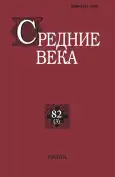COMPARISON OF NAMESAKE RULERS IN THE DANISH HISTORIOGRAPHY AT THE END OF THE XII CENTURY AS A MEANS OF LEGITIMIZING POWER
- Authors: Chesta S.O1
-
Affiliations:
- Lomonosov Moscow State University, Faculty of History
- Issue: Vol 82, No 3 (2021)
- Pages: 30-47
- Section: Articles
- URL: https://journals.eco-vector.com/0131-8780/article/view/630840
- DOI: https://doi.org/10.7868/S0131878021030028
- ID: 630840
Cite item
Abstract
The article examines the interrelationships between three historical sources: «Deeds of the Danes» by Saxo Grammaticus (c. 1208/1206), the anonymous «History of the Danish Campaign to Jerusalem» (before 1202), and the privilege of the Lund Cathedral (1186). Textual analysis has shown that all these texts compare the Danish king Cnut VI (1182–1202) with his namesake ancestors. Each such comparison serves to glorify the Danish king and legitimize his power. The article is intended to demonstrate that, at first glance, independent texts form a single ideological field.
About the authors
S. O Chesta
Lomonosov Moscow State University, Faculty of History
Email: sochesta@yandex.ru
Moscow, Russian Federation
References
- Не только саги…: ранняя история Норвегии в средневековых памятниках / сост. и общ. ред. С.Ю. Агишев. СПб., 2017.
- Успенский Б.А. Из истории имянаречения: запрет на повторение имени отца при наименовании ребенка // Именослов: История языка. История культуры / отв. ред. Ф.Б. Успенский. М., 2012. С. 26–33 (Тр. Центра славяно-германских исследований; Вып. II).
- Успенский Ф.Б. Имя и власть: выбор имени как инструмент династической борьбы в средневековой Скандинавии. М., 2001.
- Baldwin J.W. The Government of Philip Augustus: Foundations of French Royal Power in the Middle Ages. Berkley; Los Angeles; London, 1986.
- Gertz M.Cl. Fortale til Series et genealogiae regum Danorum // Scriptores minores Historiae Danicae medii aevi. København, 1970. Vol. I / Udg. af M.Cl. Gertz. S. 147–156.
- Hermanson L. Friendship, love, and brotherhood in medieval Europe, c. 1000–1200 // The Northern World: North Europe and the Baltic c. 400–1700 AD: Peoples, Economies and Cultures / Ed. by J.V. Sigurđsson, P. Gorecki, S. Murdoch. Leiden, 2019. Vol. 85.
- Hoffmann E. Königserhebung und Thronfolgeordnung in Dänemark bis zum Ausgang des Mittelalters // Beiträge zur Geschichte und Quellenkunde des Mittelalters / Hrsg. von H. Fuhrmann. Berlin; New York, 1976. Bd. 5.
- Rousseau C.M. Neither Bewitched nor Beguiled: Philip Augustus’s Alleged Impotence and Innocent III’s Response // Speculum. 2014. Vol. 89, N 2. P. 410–436.
- Skovgaard-Petersen K. Korstogtematik i Historia de Profectione Danorum in Hierosolymam // Olavslegenden og den latiske historieskrivning i 1100-tallets Norge / Udg. af I. Ekrem, L.B. Mortensen, K. Skovgaard-Petersen. København, 2000. S. 281–302.
- Storm G. Vore Forfaedre Tro paa Sjaelevandring og deres Opkaldelsessystem // Arkiv för Nordisk Filologi. 1893. H. 9. S. 199–222.
- Tiden indtil 1340 // Danmarks historie / Udg. af I. Skovgaard-Petersen, A.E. Christensen, H. Paludan. København, 1978. Bd. 1.
- The Works of Sven Aggesen Twelth-Century Danish Historian / Transl. with Introd. and Notes by Eric Christiansen. London, 1992.
- Weibull L. Knut den Heliges Gåvobrav // Historisk Tidsskrift. 1925. Vol. 9, N 3. S. 104–147.
Supplementary files








